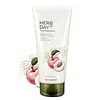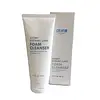What's inside
What's inside
 Key Ingredients
Key Ingredients

 Benefits
Benefits

 Concerns
Concerns

 Ingredients Side-by-side
Ingredients Side-by-side

Water
Skin ConditioningMyristic Acid
CleansingGlycerin
HumectantStearic Acid
CleansingPotassium Hydroxide
BufferingLauric Acid
CleansingGlycol Distearate
EmollientPolysorbate 20
EmulsifyingCocamidopropyl Betaine
CleansingGlyceryl Stearate
EmollientPEG-100 Stearate
PEG-7 Glyceryl Cocoate
EmulsifyingParfum
MaskingDisodium EDTA
Butylene Glycol
HumectantAnthemis Nobilis Flower Extract
MaskingAspalathus Linearis Extract
Skin ConditioningBorago Officinalis Extract
EmollientCentaurea Cyanus Flower Extract
AstringentLilium Candidum Flower Extract
Skin ConditioningSalvia Officinalis Leaf Extract
CleansingEuterpe Oleracea Fruit Extract
Malpighia Punicifolia Fruit Extract
AntioxidantCitronellol
PerfumingLimonene
PerfumingHexyl Cinnamal
PerfumingLinalool
PerfumingWater, Myristic Acid, Glycerin, Stearic Acid, Potassium Hydroxide, Lauric Acid, Glycol Distearate, Polysorbate 20, Cocamidopropyl Betaine, Glyceryl Stearate, PEG-100 Stearate, PEG-7 Glyceryl Cocoate, Parfum, Disodium EDTA, Butylene Glycol, Anthemis Nobilis Flower Extract, Aspalathus Linearis Extract, Borago Officinalis Extract, Centaurea Cyanus Flower Extract, Lilium Candidum Flower Extract, Salvia Officinalis Leaf Extract, Euterpe Oleracea Fruit Extract, Malpighia Punicifolia Fruit Extract, Citronellol, Limonene, Hexyl Cinnamal, Linalool
Glycerin
HumectantPotassium Myristate
EmulsifyingWater
Skin ConditioningButylene Glycol
HumectantPotassium Cocoyl Glycinate
Potassium Stearate
CleansingCocamidopropyl Betaine
CleansingMyristic Acid
CleansingSodium Methyl Cocoyl Taurate
CleansingPotassium Laurate
EmulsifyingPEG-40 Stearate
EmulsifyingLauric Acid
CleansingGlyceryl Stearate
EmollientPEG-100 Stearate
Parfum
MaskingStearic Acid
CleansingTocopheryl Acetate
AntioxidantCordyceps Sinensis Extract
AntioxidantPhellinus Linteus Extract
Skin ConditioningPhellinus Linteus/Rice Ferment Extract
EmollientPhellodendron Amurense Bark Extract
Skin ConditioningRheum Palmatum Root/Stalk Extract
AstringentScutellaria Baicalensis Root Extract
AstringentSophora Angustifolia Root Extract
Skin ConditioningAlthaea Officinalis Leaf/Root Extract
EmollientAnthemis Nobilis Flower Extract
MaskingFoeniculum Vulgare Leaf Extract
HumectantHouttuynia Cordata Extract
Skin ConditioningLavandula Angustifolia Flower
Skin ConditioningOcimum Basilicum Flower/Leaf Extract
TonicRosmarinus Officinalis Extract
AntimicrobialBeta-Glucan
Skin ConditioningTrisodium EDTA
Pyrus Malus Fruit Water
Masking1,2-Hexanediol
Skin ConditioningGlycerin, Potassium Myristate, Water, Butylene Glycol, Potassium Cocoyl Glycinate, Potassium Stearate, Cocamidopropyl Betaine, Myristic Acid, Sodium Methyl Cocoyl Taurate, Potassium Laurate, PEG-40 Stearate, Lauric Acid, Glyceryl Stearate, PEG-100 Stearate, Parfum, Stearic Acid, Tocopheryl Acetate, Cordyceps Sinensis Extract, Phellinus Linteus Extract, Phellinus Linteus/Rice Ferment Extract, Phellodendron Amurense Bark Extract, Rheum Palmatum Root/Stalk Extract, Scutellaria Baicalensis Root Extract, Sophora Angustifolia Root Extract, Althaea Officinalis Leaf/Root Extract, Anthemis Nobilis Flower Extract, Foeniculum Vulgare Leaf Extract, Houttuynia Cordata Extract, Lavandula Angustifolia Flower, Ocimum Basilicum Flower/Leaf Extract, Rosmarinus Officinalis Extract, Beta-Glucan, Trisodium EDTA, Pyrus Malus Fruit Water, 1,2-Hexanediol
 Reviews
Reviews

Ingredients Explained
These ingredients are found in both products.
Ingredients higher up in an ingredient list are typically present in a larger amount.
Anthemis Nobilis Flower Extract is from the Roman Chamomile flower. It helps soothe the skin and contains antioxidants.
Butylene Glycol (or BG) is used within cosmetic products for a few different reasons:
Overall, Butylene Glycol is a safe and well-rounded ingredient that works well with other ingredients.
Though this ingredient works well with most skin types, some people with sensitive skin may experience a reaction such as allergic rashes, closed comedones, or itchiness.
Learn more about Butylene GlycolCocamidopropyl Betaine is a fatty acid created by mixing similar compounds in coconut oil and dimethylaminopropylamine, a compound with two amino groups.
This ingredient is a surfactant and cleanser. It helps gather the dirt, pollutants, and other impurities in your skin to be washed away. It also helps thicken a product and make the texture more creamy.
Being created from coconut oil means Cocamidopropyl Betaine is hydrating for the skin.
While Cocamidopropyl Betaine was believed to be an allergen, a study from 2012 disproved this. It found two compounds in unpure Cocamidopropyl Betaine to be the irritants: aminoamide and 3-dimethylaminopropylamine. High-grade and pure Cocamidopropyl Betaine did not induce allergic reactions during this study.
Learn more about Cocamidopropyl BetaineGlycerin is already naturally found in your skin. It helps moisturize and protect your skin.
A study from 2016 found glycerin to be more effective as a humectant than AHAs and hyaluronic acid.
As a humectant, it helps the skin stay hydrated by pulling moisture to your skin. The low molecular weight of glycerin allows it to pull moisture into the deeper layers of your skin.
Hydrated skin improves your skin barrier; Your skin barrier helps protect against irritants and bacteria.
Glycerin has also been found to have antimicrobial and antiviral properties. Due to these properties, glycerin is often used in wound and burn treatments.
In cosmetics, glycerin is usually derived from plants such as soybean or palm. However, it can also be sourced from animals, such as tallow or animal fat.
This ingredient is organic, colorless, odorless, and non-toxic.
Glycerin is the name for this ingredient in American English. British English uses Glycerol/Glycerine.
Learn more about GlycerinGlyceryl Stearate is a mix of glycerin and stearic acid.
It is used to stabilize the mixing of water and oil ingredients. By preventing these ingredients from separating, it can help elongate shelf life. It can also help thicken the product's texture.
As an emollient, it helps soften skin and supports barrier-replenishing ingredients.
In cosmetics, Glyceryl Stearate is often made from vegetable oils or synthetically produced.
This ingredient may not be fungal-acne safe
Fun fact: The human body also creates Glyceryl Stearate naturally.
Learn more about Glyceryl StearateLauric Acid is a fatty acid or lipid. About half of fatty acids in coconut oil is lauric acid.
This ingredient helps hydrate and sooth skin. As a humectant, it helps trap moisture. It also aids in cleaning and enhancing the texture of products.
Lauric acid may not be Malassezia folliculitis, or fungal acne, safe.
Learn more about Lauric AcidMyristic Acid is a saturated fatty acid. It is naturally found in milk fat. Other sources include palm oil, coconut oil, and butter fat.
Myristic Acid is an emulsifer and cleanser. As an emulsifer, it stabilizes a product by preventing ingredients from separating. Myristic Acid helps clean your skin by acting as a surfactant. It tends to gather oil and dirt on your skin to be easily rinsed away.
One study from 2021 found Myristic Acid to have anti-inflammatory properties.
Learn more about Myristic AcidParfum is a catch-all term for an ingredient or more that is used to give a scent to products.
Also called "fragrance", this ingredient can be a blend of hundreds of chemicals or plant oils. This means every product with "fragrance" or "parfum" in the ingredients list is a different mixture.
For instance, Habanolide is a proprietary trade name for a specific aroma chemical. When used as a fragrance ingredient in cosmetics, most aroma chemicals fall under the broad labeling category of “FRAGRANCE” or “PARFUM” according to EU and US regulations.
The term 'parfum' or 'fragrance' is not regulated in many countries. In many cases, it is up to the brand to define this term.
For instance, many brands choose to label themselves as "fragrance-free" because they are not using synthetic fragrances. However, their products may still contain ingredients such as essential oils that are considered a fragrance by INCI standards.
One example is Calendula flower extract. Calendula is an essential oil that still imparts a scent or 'fragrance'.
Depending on the blend, the ingredients in the mixture can cause allergies and sensitivities on the skin. Some ingredients that are known EU allergens include linalool and citronellol.
Parfum can also be used to mask or cover an unpleasant scent.
The bottom line is: not all fragrances/parfum/ingredients are created equally. If you are worried about fragrances, we recommend taking a closer look at an ingredient. And of course, we always recommend speaking with a professional.
Learn more about ParfumPeg-100 Stearate is an emollient and emulsifier. As an emollient, it helps keep skin soft by trapping moisture in. On the other hand, emulsifiers help prevent oil and water from separating in a product.
PEGS are a hydrophilic polyether compound . There are 100 ethylene oxide monomers in Peg-100 Stearate. Peg-100 Stearate is polyethylene glycol ester of stearic acid.
Stearic Acid is a fatty acid. It is an emollient, emulsifier, and texture enhancer.
As an emollient, stearic acid helps soften skin. It aids the skin's protective barrier by preventing water loss. It also provides a gentle cleansing effect without stripping away natural oils.
Stearic acid may also be used to enhance the texture of products. It can add volume and stabilize ingredients such as water and oil. This can help water and oil ingredients from separating.
Sources of stearic acid include animal or vegetable fats/oils such as coconut or shea. It can be naturally found in butter, cocoa butter, shea butter, vegetable fats, and animal tallow.
This ingredient may not be Malassezia folliculitis, or fungal-acne safe.
Learn more about Stearic AcidWater. It's the most common cosmetic ingredient of all. You'll usually see it at the top of ingredient lists, meaning that it makes up the largest part of the product.
So why is it so popular? Water most often acts as a solvent - this means that it helps dissolve other ingredients into the formulation.
You'll also recognize water as that liquid we all need to stay alive. If you see this, drink a glass of water. Stay hydrated!
Learn more about Water